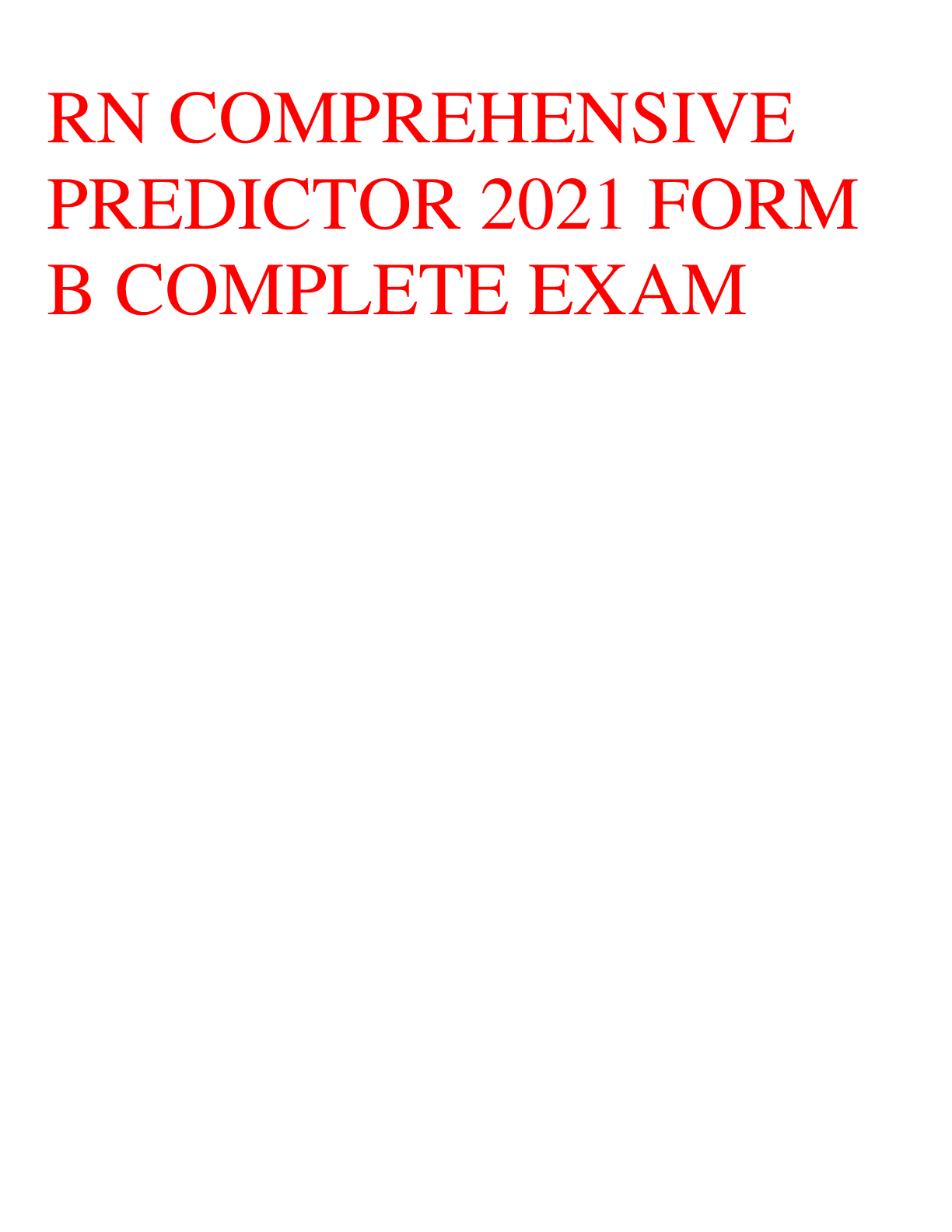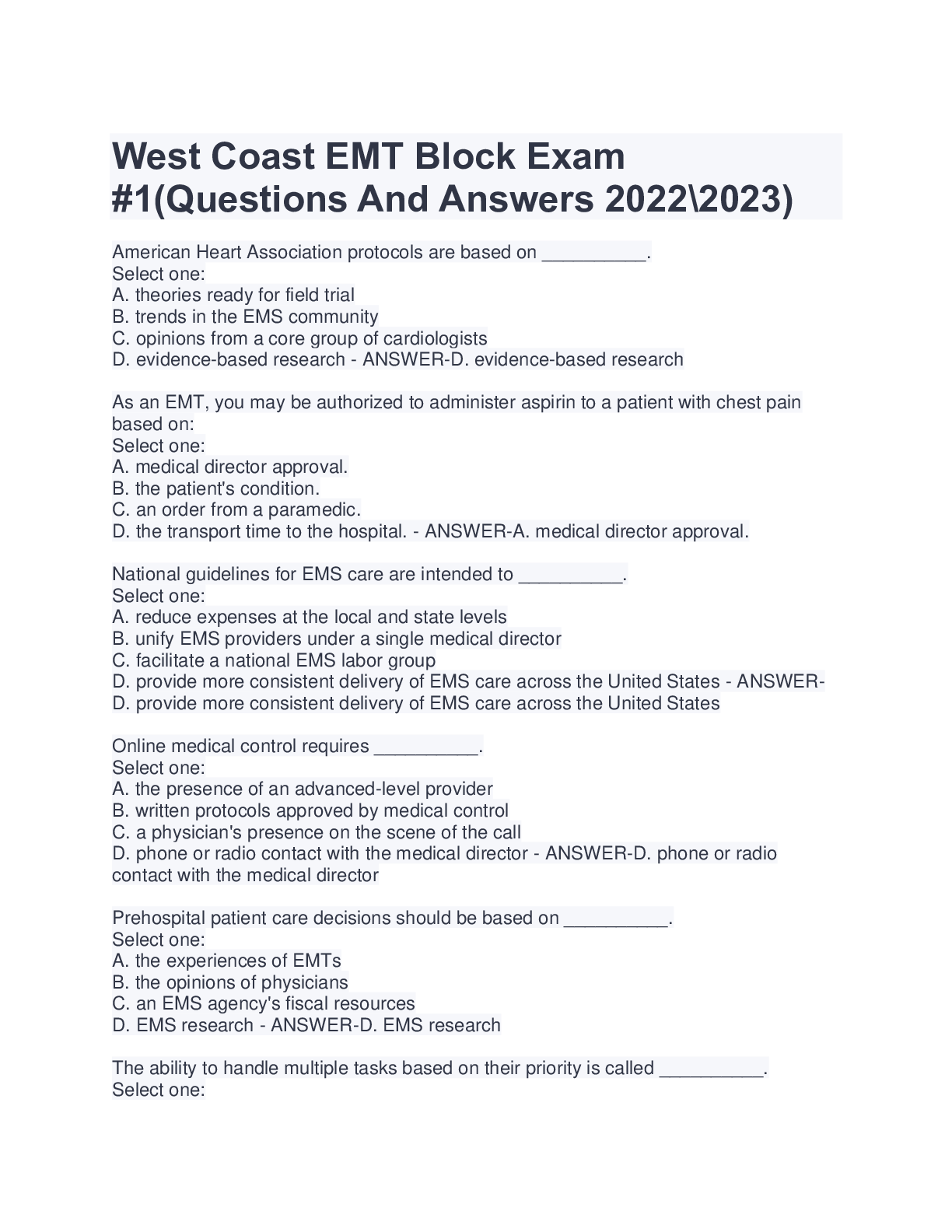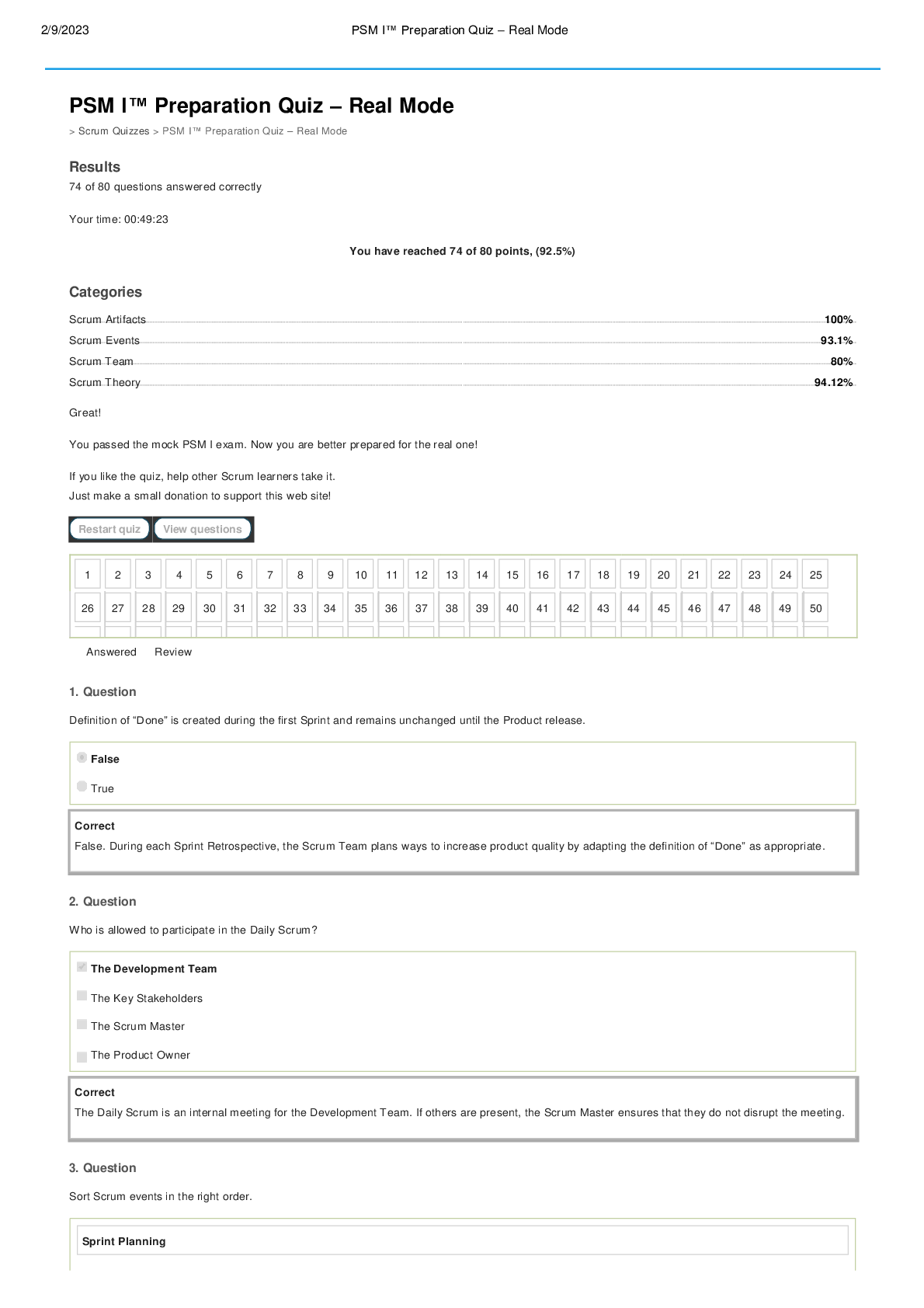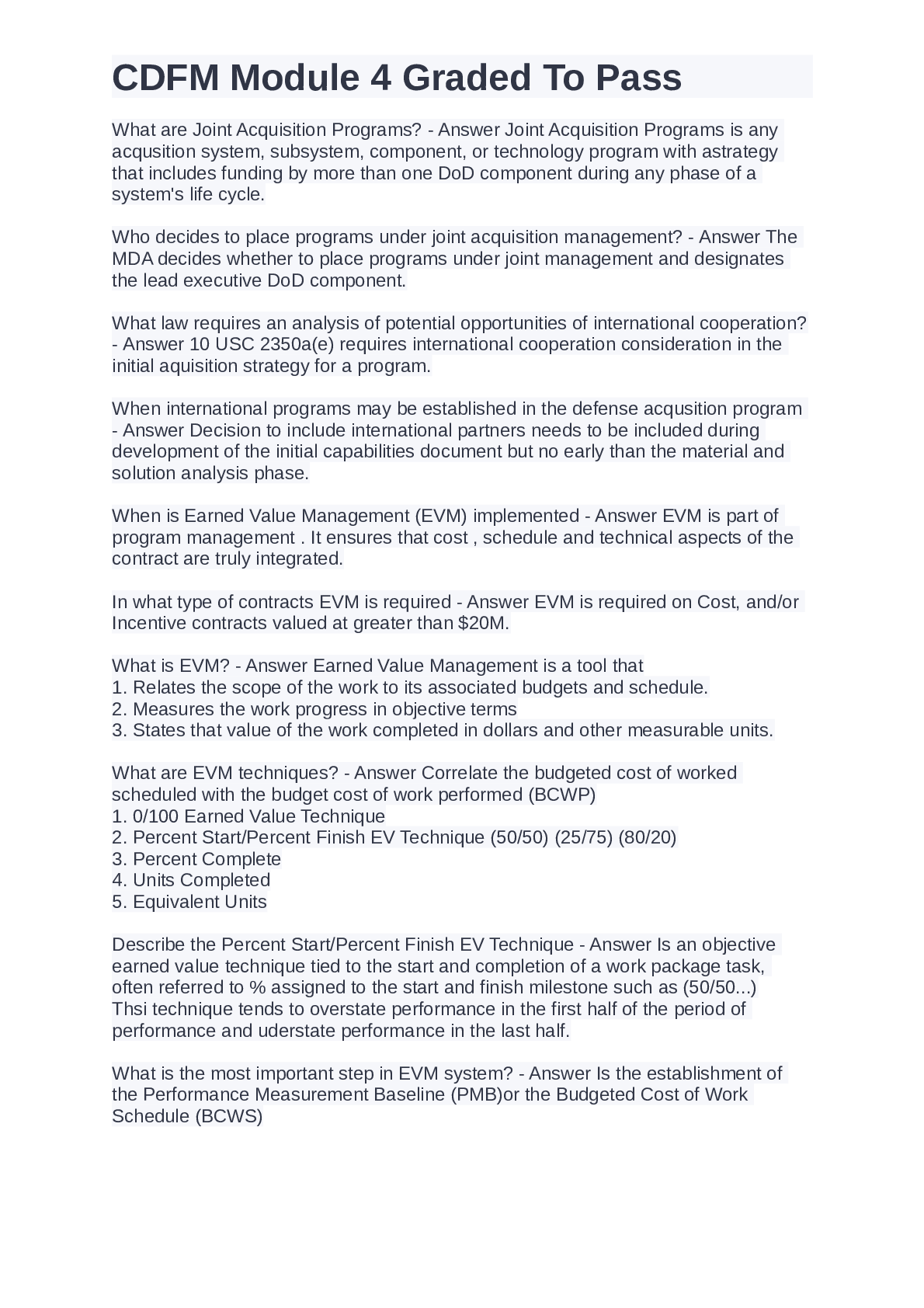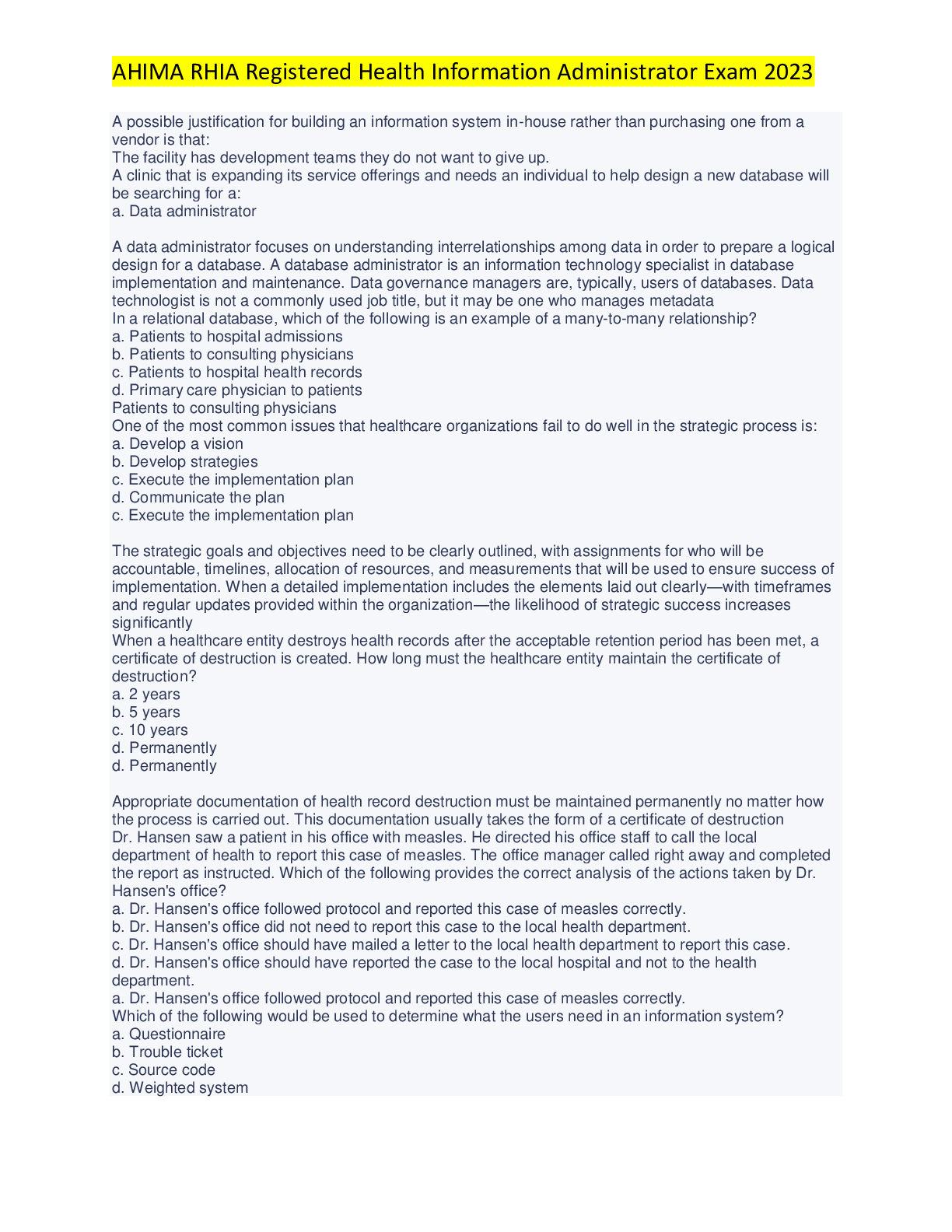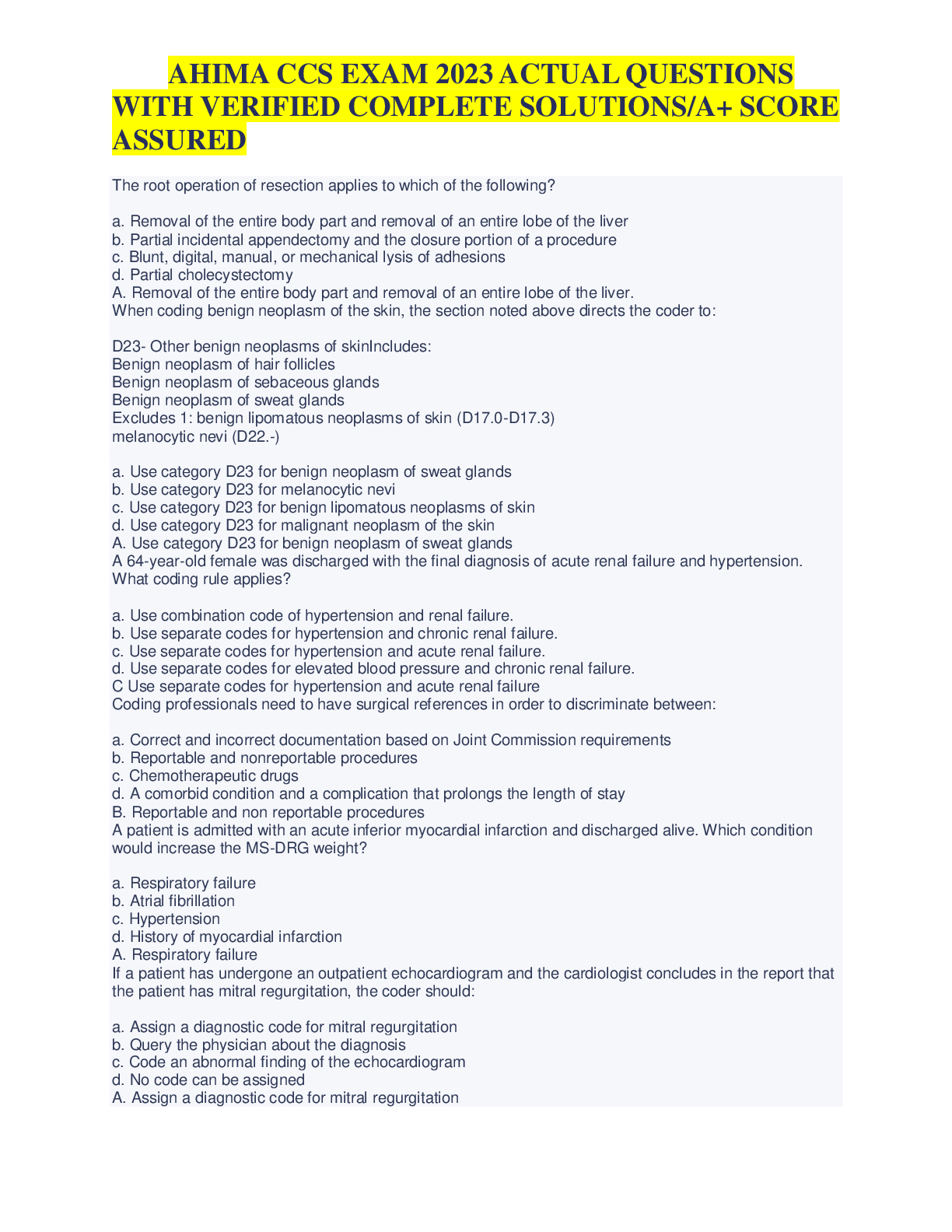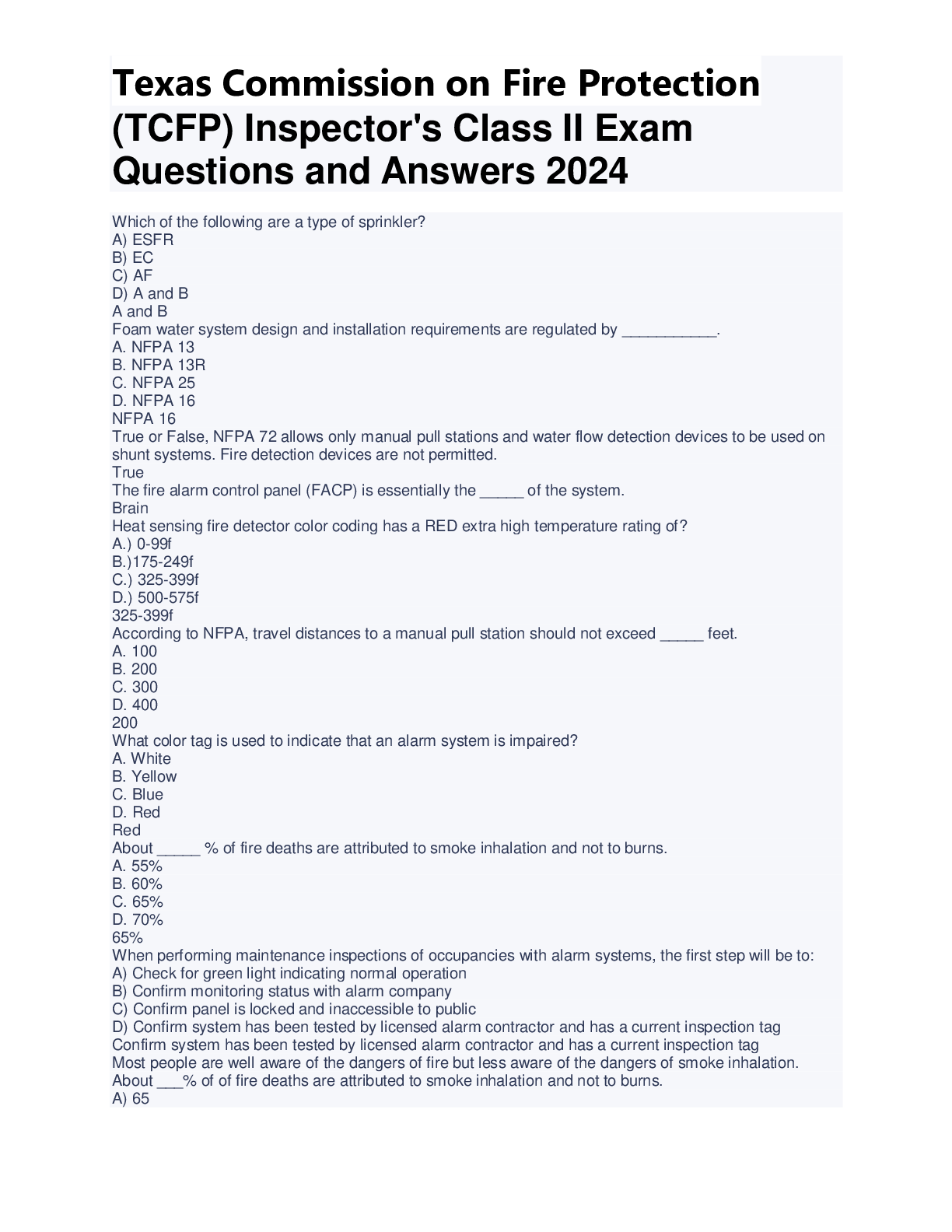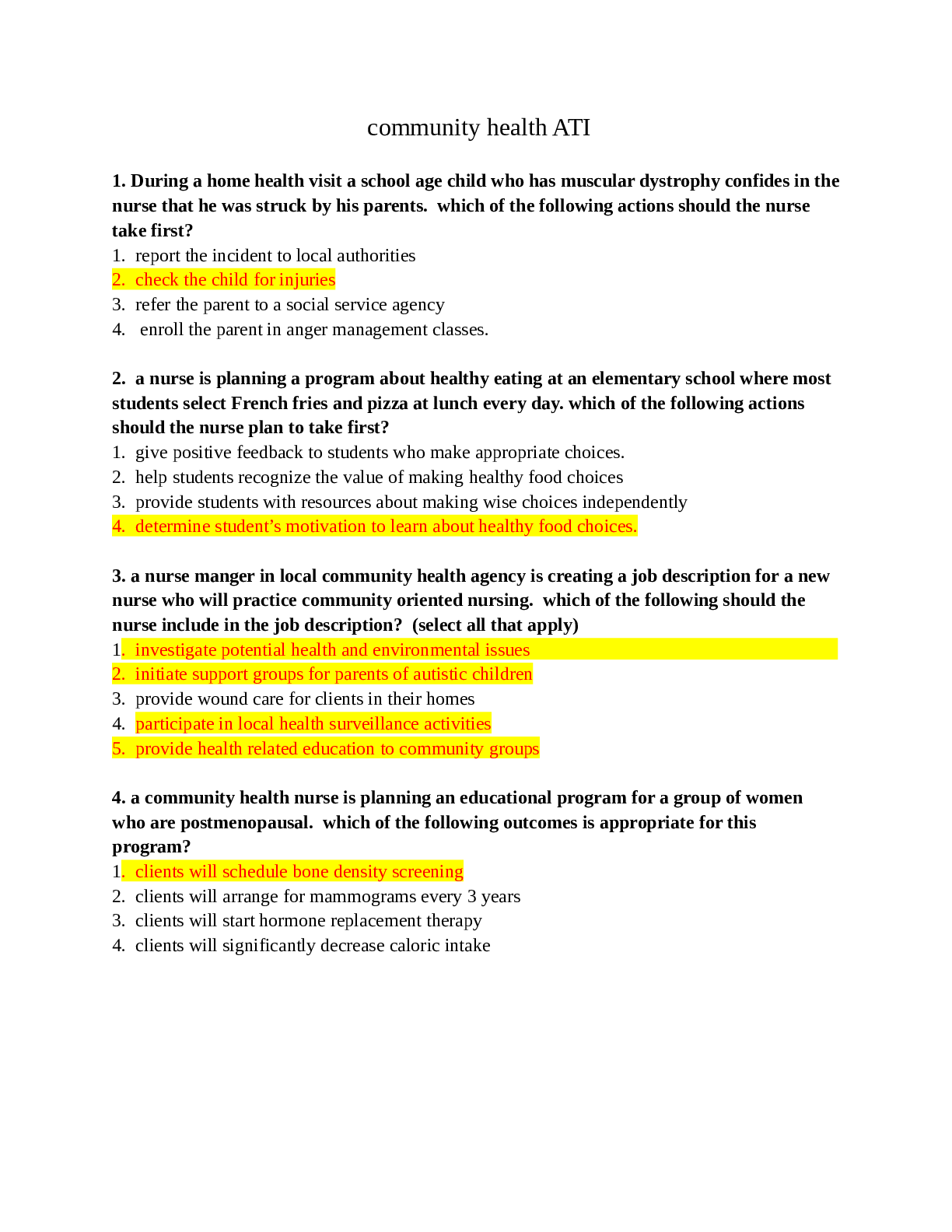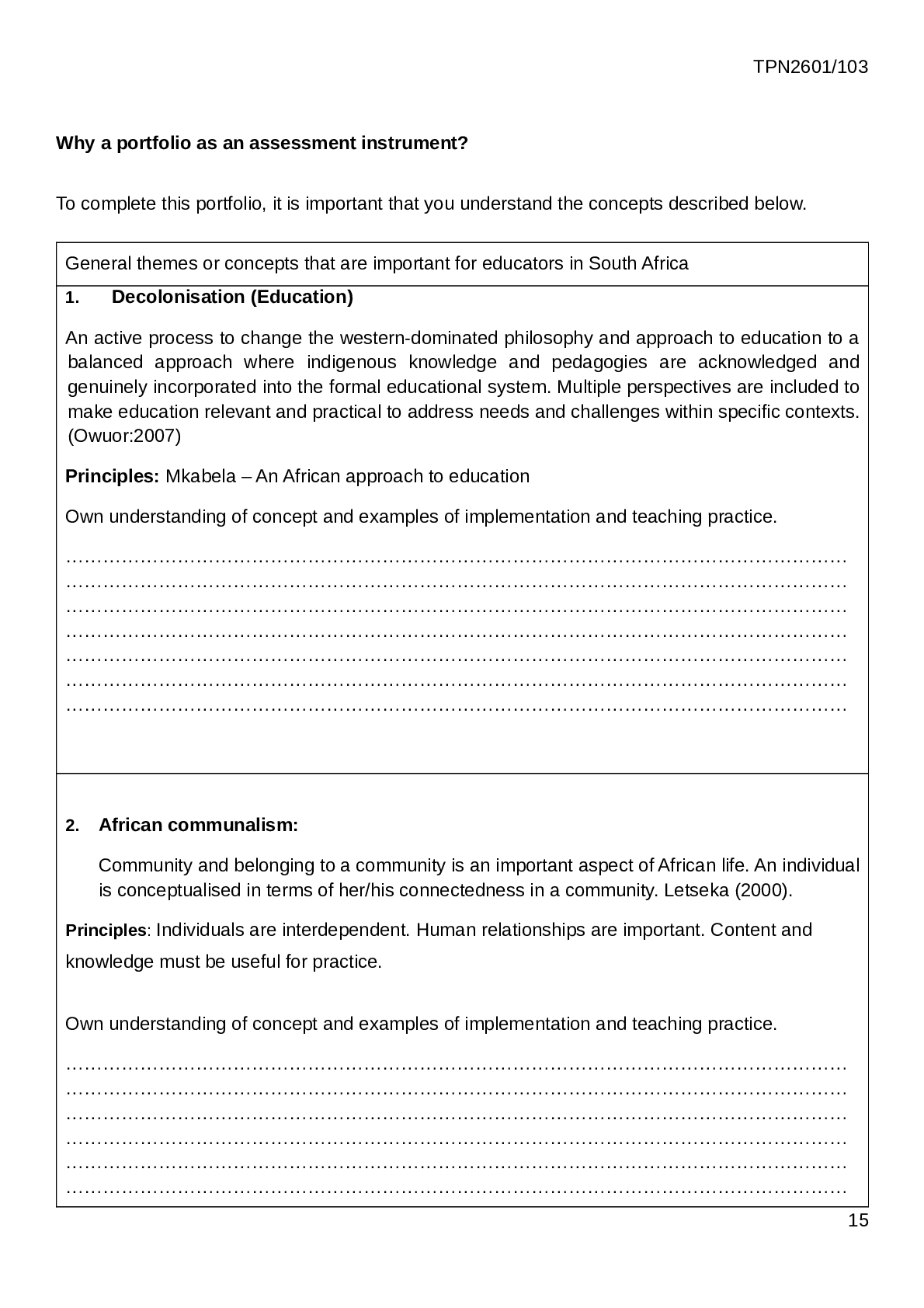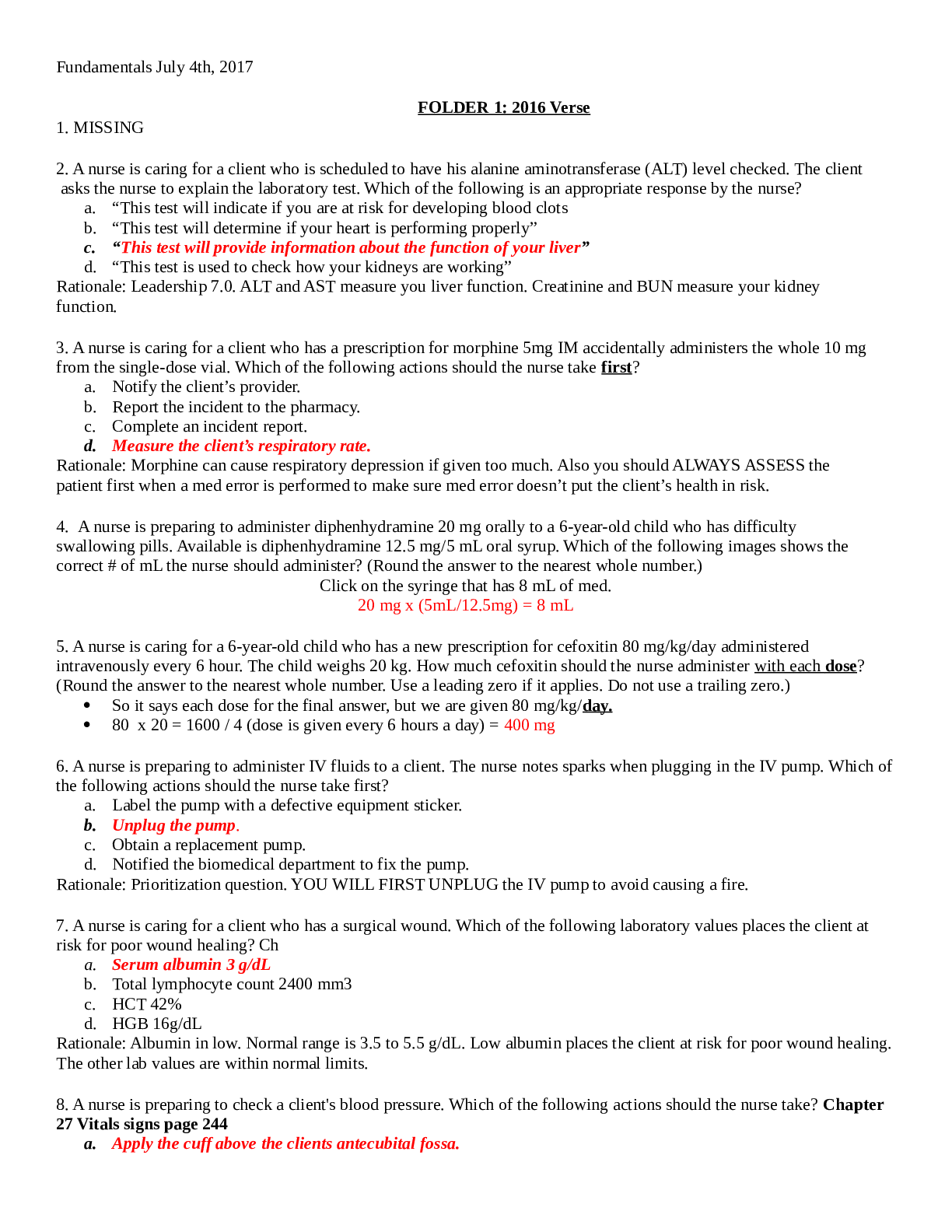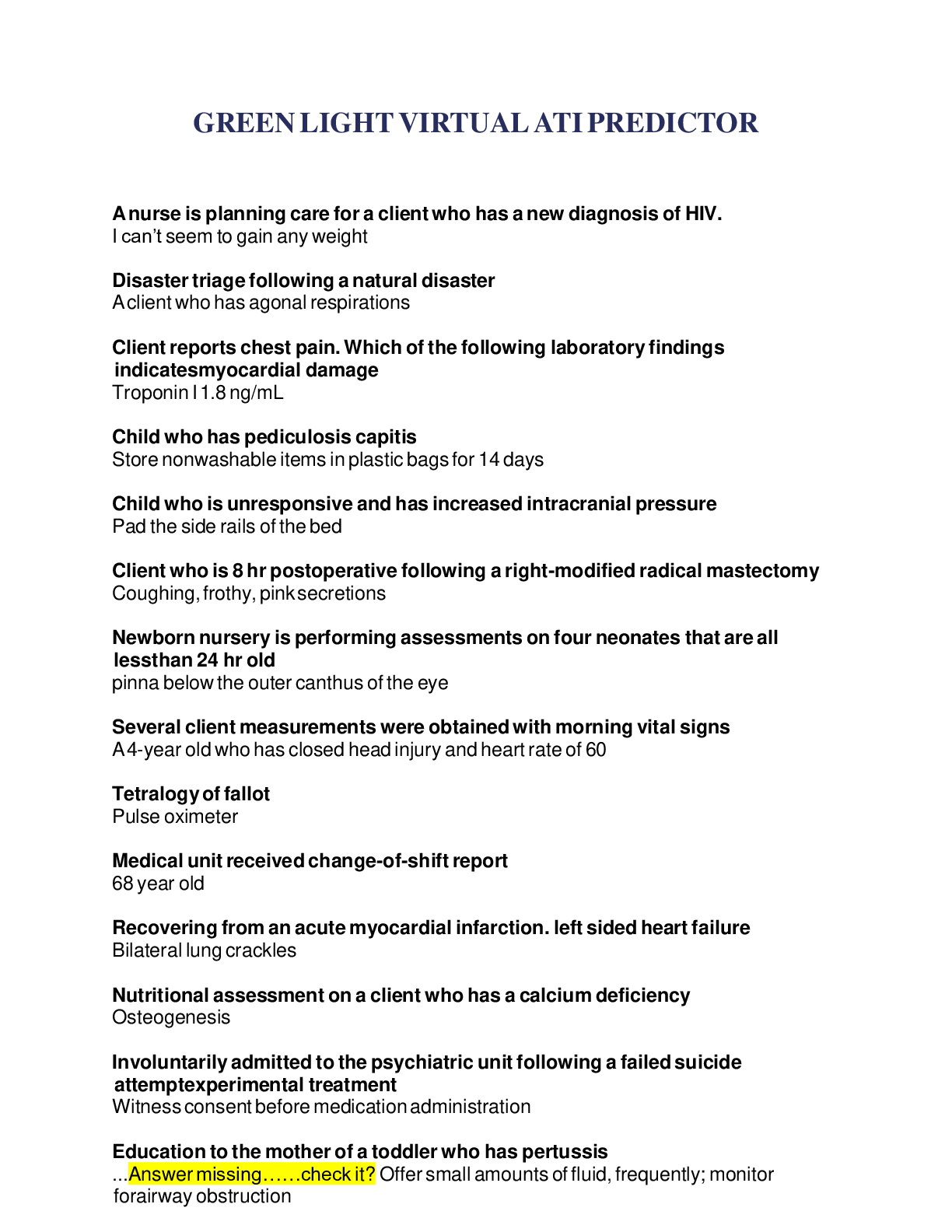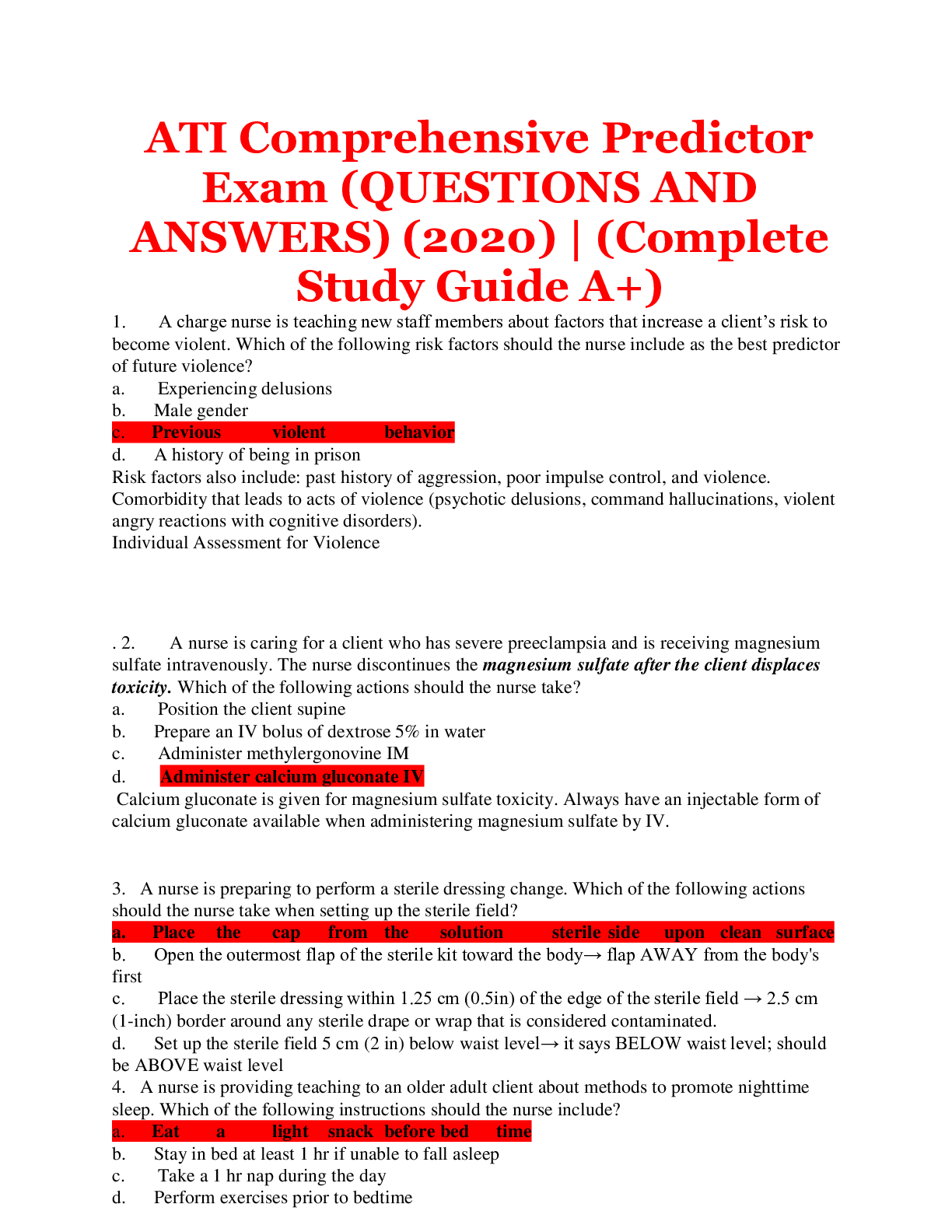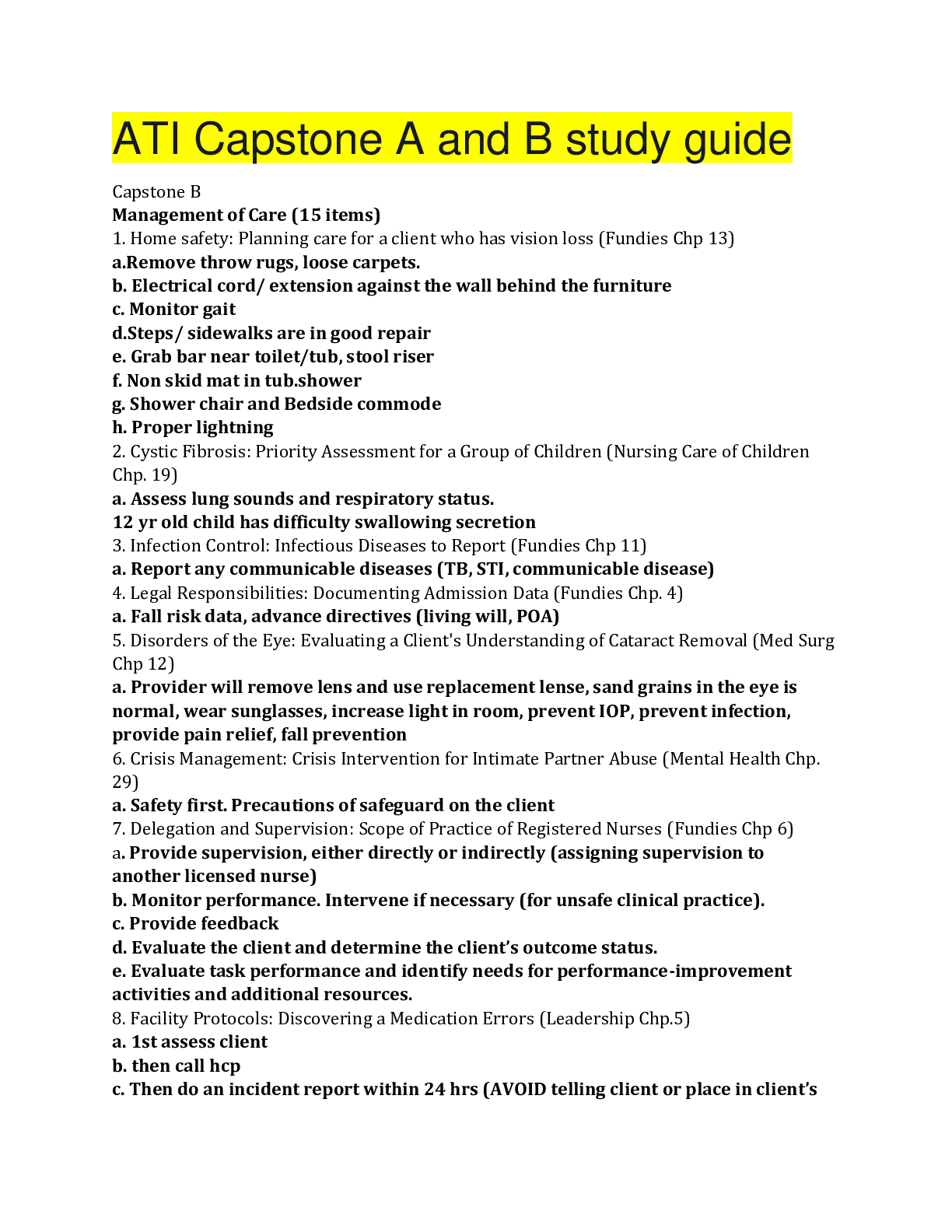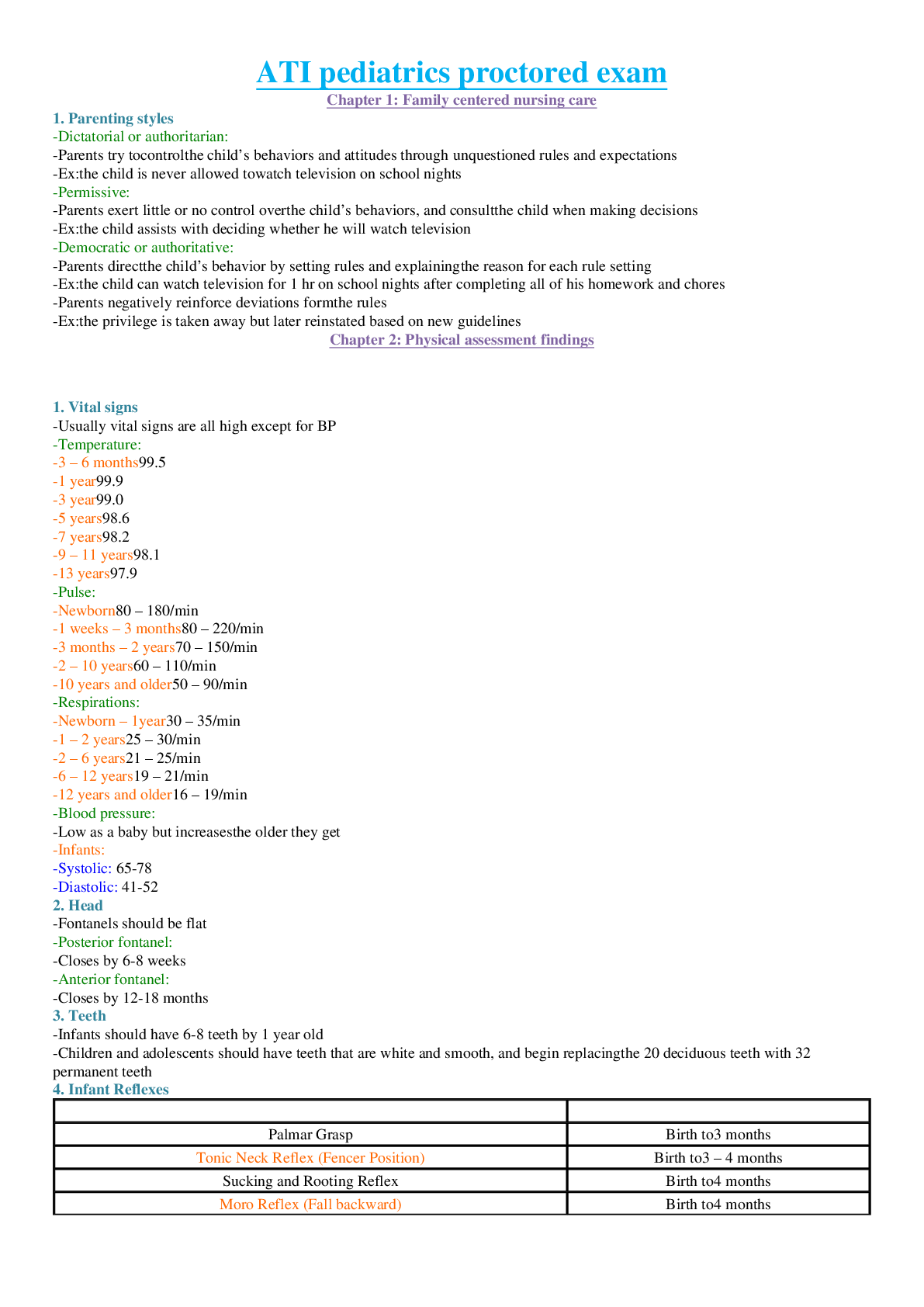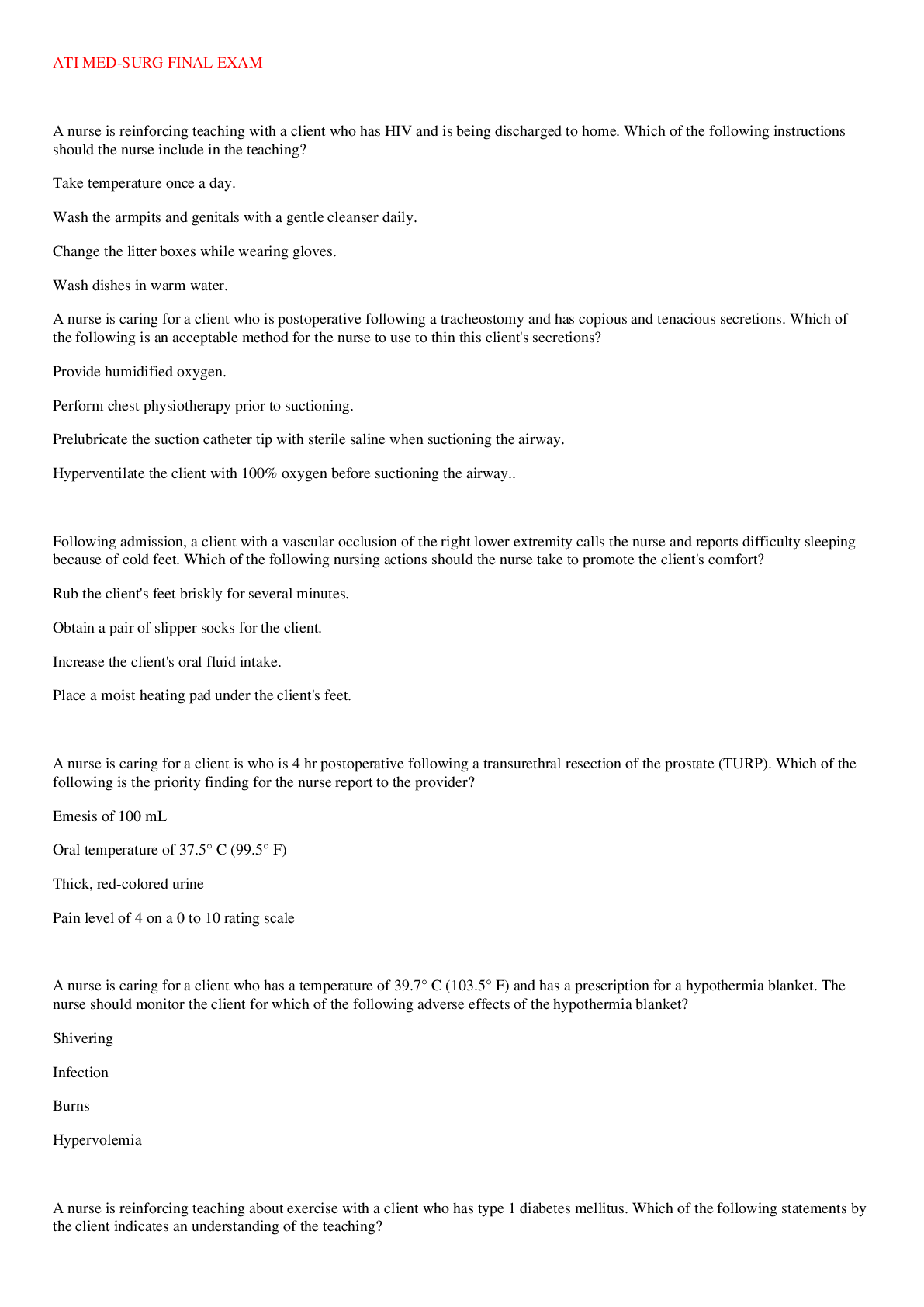*NURSING > QUESTIONS and ANSWERS > ATI MED SURG EXAM: Respiratory Answers Marked (REVISED) Pass Guaranteed. (All)
ATI MED SURG EXAM: Respiratory Answers Marked (REVISED) Pass Guaranteed.
Document Content and Description Below
1- A charge nurse receives notification of the admission of a client who is coughing frequently and whose sputum is pink, frothy, and copious. The client has history of night sweats, anorexia, and w... eight loss. Which of the following actions should the nurse take? (SATA) -Assign the client to a private room with negative-pressure airflow -Wear an N95 respirator when entering the client’s room. 2- A nurse is assisting a provider with a comprehensive physical examination of a client. When the provider uses transillumination, the nurse should explain to the client that this technique help evaluate which of the following structures? -Maxillary sinuses 3- A nurse is caring for a client who smokes cigarettes and has a new diagnosis of emphysema. How should the nurse assist the client with smoking cessation? -Discuss ways the client can reduce the number of cigarettes smoked per day. 4- A nurse is planning care for a client who has chronic obstructive pulmonary disease (COPD) and is malnourished. Which of the following recommendations to promote nutritional intake should the nurse include in the plan? -Eat high-calorie food first. Rational: client who has COPD experience early satiety. Client should eat calorie-dense food first. 5- A nurse is preparing to administer cisplatin IV to a client who has lung cancer. The nurse should identify that which of the following findings is an adverse effect of this medication? -Tinnitus. Rational: An adverse effect of cisplatin is ototoxicity, which can cause tinnitus. 6- A nurse in a medical-surgical unit is assessing a client. The nurse should identify that which of the following findings is a manifestation of a pulmonary embolism? -Stabbing chest pain Rational: sudden chest pain that is sharp and stabbing is a manifestation of pulmonary embolism. Other manifestations include dyspnea, coughing, hemoptysis (coughing up blood), tachypnea, tachycardia, diaphoresis, and feeling of impending doom. 7- A nurse in the PACU is assessing a newly admitted client and observes intercostal retractions and a high-pitched inspiratory sound (stridor). The nurse should identify theses findings as manifestations of which of the following complications? -Respiratory obstruction 8- A nurse is reviewing the laboratory results of a client who has metabolic alkalosis. Which of the following laboratory values should the nurse expect? -ph 7.49,HCO3-32mEq/L, PaCO2 40mmHg Rational: Metabolic alkalosis: pH and bicarbonate values are greater than the expected references range, and the PaCO2 is within the expected reference range. 9- A nurse is providing teaching to a client who has a chronic cough and is scheduled for a bronchoscopy. Which of the following client statements indicates an understanding of the teaching? -“A tissue sample might be obtained during the procedure” 10- A nurse is preparing a client for a bronchoscopy. Which of the following actions should the nurse take? (SATA) -Explain that the client will receive sedation and will not remember the procedure. -Verify that the client understands the purpose and nature of the procedure. 11- A nurse is preparing a client for discharge following a bronchoscopy. Which of the following assessment is the nurse’s monitoring priority? -Confirming the gag reflex Rational: The greater risk to the client’s safety is aspiration resulting from a depressed gag reflex. 12- A nurse is caring for a client who is postoperative following a thoracic lobectomy. The client has 2 chest tubes in place: 1 in the lower portion of the thorax and the other higher on the chest wall. When a family member asks why the client has 2 chest tubes, which of the following responses should the nurse make? -“The lower tube will drain blood, and the higher tube will remove air.” 13- A nurse is providing teaching to a client who will undergo a total laryngectomy. Which of the following statements indicate that the client understands the impact of the surgery? - “I understands that I will have a permanent tracheostomy after the surgery.” Rational: With a partial laryngectomy, the tracheostomy is temporary. With the total laryngectomy the tracheostomy will be permanent. 14- A nurse is providing discharge instructions to a client who has a new laryngectomy. The nurse tells the client to be careful while bathing to prevent which of the following complications? -Aspiration of water. Rational: This is a client with a tracheostomy, so he will need to use a shower shield over the stoma when bathing or showering to keep water out of the airway. 15- A nurse is caring for a client who is extremely anxious and is hyperventilating. The client’s ABG results are pH 7.50, PaCO2 27 mmHg, and HCO3-25 mEq/L. The nurse should identify that the client has which of the following acid-base imbalances? -Respiratory alkalosis. 16- A nurse is planning postoperative education for a client who will undergo a radical neck dissection for cancer of the larynx. The nurse should include which of the following topics? (SATA) -NPO status -Alternative methods of communication - Changes in body image -Swallowing exercises. 17- A nurse in a clinic is providing teaching for a client who is scheduled to have a tuberculin skin test. Which of the following pieces of information should the nurse include? - “You must return to the clinic to have the test read in 2 or 3 days.” 18- A nurse is providing discharge teaching to a client who is postoperative following a rhinoplasty/ Which of the following instructions should the nurse include? “Lie on your back with your head elevated 30º when resting.” 19- A nurse is preparing to assist provider with an arterial blood withdrawal from a client’s radial artery for ABG measurements. Which of the following actions the nurse plan to take? -Perform an Allen’s test prior to obtaining the specimen. Rational: the nurse should ensure that the circulation of the hands is adequate from the ulnar artery in case the radial artery is injured from the blood draw. The most common site for withdrawal of arterial blood gases is the radial artery. 20- A nurse is providing teaching to a client about pulmonary function testing. Which of the following tests measures the volume of air the lungs can holds at the end of maximum inhalation? -Total lung capacity 21- A nurse is providing preoperative teaching to a client who is to undergo a pneumonectomy. The client states, “I am afraid coughing will hurt after surgery.” Which of the following statements by the nurse is appropriate? -“I will show you how to splint your incision while coughing.” 22- A nurse is caring for a client who has a tracheostomy and is receiving mechanical ventilation. When the low-pressure alarm on the ventilator sounds, it indicates which of the following to the nurse? -A leak within the ventilator’s circuitry. 23- A nurse is caring for a client who is postoperative following a rhinoplasty. Which of the following findings should the nurse report to the surgeon? -Frequent swallowing Rational: this indicates posterior nasal bleeding and possibly hemorrhage. 24- A nurse is caring for a client immediately following extubation. Which of the following manifestations indicates that the nurse should call the rapid response team? -Stridor Rational: the nurse should identify that stridor (high-pitched crowing sound heard during inspiration) is caused by laryngeal edema and can indicate impending airway obstruction. 25- A nurse is caring for a client who has a chest tube. The nurse notes that the chest tube has become disconnected from the chest drainage system. Which of the following actions should the nurse take? -Immerse the end of the chest tube in a bottle of sterile water. 26- A nurse is caring for a client following a right pleural thoracentesis. The nurse measures a total of 35 ml of purulent drainage. Which of the following findings should the nurse recognize as an indication of tension pneumothorax? (SATA) -Tracheal deviation to the left -Absent breath sounds on the right side -Neck vein distention 27- A nurse is providing discharge teaching to a client who has emphysema. Which of the following instructions should the nurse include? -“Try to drink at least 2 to 3 liters of fluid per day” Rational: clients who have emphysema should drink 2 to 3 L per day to help liquefy secretions. 28- A nurse is caring for a client who had a left lower lobectomy to treat lung cancer. Which of the following factors will have a significant impact on the plan of care for this client? -Lung cancer usually has metastasized before the client present with symptoms. 29- A nurse is assessing a client who has a positive tuberculin skin test. Which of the following findings indicates that the client has active tuberculosis? -Night sweats. Rational: manifestations of active tuberculosis include a fever, coughing, night sweats, anorexia, and fatigue. 30- A nurse is providing discharge teaching to a client who had a pulmonary embolism. Which of the following statements indicates that the client understands the information? -“I’ll call the doctor if I see any blood in my urine or stool.” Rational: bleeding precautions are essential to clients who had a pulmonary embolism because they taken an anticoagulant. They should report any signs of bleeding immediately. 31- A nurse is caring for a client whom the respiratory therapist has just removed the endotracheal tube. Which of the following actions should the nurse take first? -Evaluate the client for stridor 32- A nurse in a provider’s office is assessing a client who states he was recently exposed to tuberculosis. Which of the following findings is a clinical manifestation of pulmonary tuberculosis? -Night sweats 33- A nurse on a medical-surgical unit is caring for a client who is postoperative following a hip replacement surgery. The client reports feeling apprehensive and restless. Which of the following findings should the nurse recognize as an indication of pulmonary embolism? -Sudden onset of dyspnea. Rational: clinical manifestations of pulmonary embolism have a rapid onset. Dyspnea occurs duet o reduced blood flow to the lungs. 34- A client is admitted to the emergency department following a motorcycle crash. The nurse notes a crackling sensation upon palpation of the right side of the client’s chest. After notifying the provider, the nurse document this finding as which of the following? -Crepitus Rational: crepitus also called subcutaneous emphysema, is a coarse crackling sensation that the nurse can feel when palpating the skin surface over the client’s chest. Crepitus indicates an air leak into the subcutaneous tissue, which is often a clinical manifestation of pneumothorax. 35- A nurse on a medical unit is caring for a client who aspirated gastric contents prior to admission. The nurse administers 100% oxygen by nonrebreather mask after the client reports severe dyspnea. Which of the following findings is a clinical manifestation of acute respiratory distress syndrome (ARDS)? -PaO2 50 mmHg Rational: client who has manifestation of ARDS has a low PaO2 level, even after the administration of oxygen. Hypoxemia after treatment with oxygen is a manifestation of ARDS. 36- A nurse is caring for an older adult client who has chronic obstructive pulmonary disease (COPD) with pneumonia. The nurse should monitor the client for which of the following acid-base imbalances? -Respiratory acidosis. Rational: respiratory acidosis is a common complication of COPD. This complication occurs because clients who have COPD are unable to exhale carbon dioxide due to a loss of elastic recoil in the lungs. 37- A nurse in an urgent care clinic is collecting data from a client who report exposure to anthrax. Which of the following findings is an indication of the prodromal stage of inhalation anthrax? -Dry cough Rational: dry cough is a clinical manifestation of the prodromal stage of inhalation anthrax. During this stage, it is difficult to distinguish the condition from influenza or pneumonia because there is no sore throat or rhinitis. 38- A nurse is caring for a client who has a tracheostomy with an inflated cuff in place. Which of the following findings indicates that the nurse should suction the client airway secretions? -The nurse auscultates coarse crackles in the lung fields. 39- A nurse is planning care for a client following placement of a chest tube 1 hr ago. Which of the following actions should the nurse include in the plan of care? -Tape all connections between the chest tube and drainage system. Rational: the nurse should tape all connections to ensure that the system is airtight and prevent the chest tubing from accidentally disconnecting. 40- A nurse in the emergency department is assessing a client for closed pneumothorax and significant bruising of the left chest following a motor-vehicle crash. The client reports severe left chest pain on inspiration. The nurse should assess the client for which of the following manifestations of pneumothorax? -Absence of breath sounds [Show More]
Last updated: 1 year ago
Preview 1 out of 31 pages

Reviews( 0 )
Document information
Connected school, study & course
About the document
Uploaded On
May 05, 2021
Number of pages
31
Written in
Additional information
This document has been written for:
Uploaded
May 05, 2021
Downloads
0
Views
29

